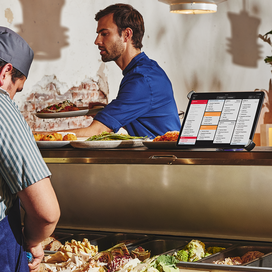Table of contents
A seasonal restaurant menu offers your customers fresh, flavorful ingredients and can help bring in more sales while keeping operational costs relatively low.
Since Starbucks launched its pumpkin spice latte in 2003, other quick-service and fast-food restaurants including Tim Hortons, Dunkin’ Donuts, Krispy Creme, and, most recently, Wendy’s have added limited-time menu items featuring the flavor. Its popularity isn’t slowing. According to Future Market Insights data, the global Pumpkin Spice Products market — worth $1.1 billion in 2023 — is expected to reach $2.4 billion by 2033. Tapping into seasonal menu trends can bring more dollars into your restaurant without much strain. That’s because when produce like pumpkin is in season, it’s more widely available and often cheaper to source and keep in stock.
Yet pumpkin spice is just one example of a seasonal ingredient you can consider adding to your menu for a limited time. From apples, squash, and citrus in the winter to tomatoes, avocados, and cherries in the summer, there’s an abundance of options all year round. And with the right restaurant technology in place, you can easily use sales data to forecast future demand and make seasonal menu decisions that bring your restaurant the most business.
Year-round considerations for your seasonal menu
To make your restaurant menu seasonal, you don’t have retire your best-selling dishes. Instead try to incorporate a few new options that feature in-season ingredients and flavors. If these are already on your menu, drawing attention to them can attract more diners to buy.
Fall menu considerations
Pumpkin starts hitting menus as early as August, when customers start to yearn for fall. It sells steadily for several weeks and often stays in stock until mid to late October. But other foods and flavors, including pho, ramen, soups, and curries, as well as caramel apple and apple cider, are also traditionally popular at this time.
Another way to think about building your seasonal menu is by paying attention to the holidays and celebrations that take place during the season, such as Oktoberfest and Thanksgiving. Traditional thanksgiving dinner favorites, such as cranberry, Brussels sprouts, kale, and more are all worthwhile options to consider for your menu.
Winter menu considerations
Winter is a great time to add warm dishes such as chilis, soups, and stews to your menu, which feature seasonal vegetables like sweet potatoes, parsnips, squash, and kale. While the holidays tend to make comfort foods popular this time of year, later rituals and celebrations such as New Year’s Eve and Dry January can influence consumers to make healthier choices. In fact, in 2022, sales of low- and non-alcoholic beverages grew by more than 7%, surpassing $11million in market value. Consider exploring mocktail options with seasonal twists, including peppermint, cranberry, gingerbread, and more flavors.
Spring menu considerations
In the spring restaurants begin to see spikes in orders for colder, fresher dishes, including poke and salads. That may be because spring produce — greens, asparagus, radishes, peas, artichokes, strawberry, rhubarb — are all in season. And as the weather warms, more diners tend to crave dishes like ice cream and dessert.
As you consider your spring restaurant menu, think about seasonal trends and promotions, such as patio season reapproaching and preparing for St. Patrick’s Day. Now is a good time to think about highlighting your beer offerings, such as Oberon Ale, which starts to become available in many states at this time and only lasts until September.
Summer menu considerations
As spring rolls into summer, things start to heat up. Recent research shows demand for spicy foods in the summer rises, especially for younger diners. A whopping 47% of Gen Z and 45% of millennials said that they prefer either moderately spicy toppings or condiments with as much heat as possible. Traditional summer produce, such as pineapple, peaches, watermelon and more also become popular during this season, opening opportunity for both food and drink menu additions.
Use your restaurant technology to guide menu decisions.
While research suggests the menu items will perform well throughout the year, every restaurant is unique. What may be a top seller for you in the spring or fall may actually surprise you. Or maybe one of your locations sells pumpkin spice at a rapid rate, while another sees higher performance of caramel apple. That’s where your restaurant technology can come in handy.
With a point-of-sale system like Square for Restaurants, you can easily access your sales data in your Dashboard. Here you’re able to see real-time information on what items sell best, on how much customers are spending, and on how often people return. This data can help you test important decisions, such as when to launch seasonal menu items and which types of items you should include and at what price range. Depending on your sales information, it might make sense to explore opportunities for dynamic pricing structures, which involve adjusting menu prices up or down depending on supply and demand.
No matter what time of the year it is, tweaking your offerings slightly can give your restaurant business a boost. And tracking that information with your technology equips your team to make decisions that are sure to succeed, which ultimately helps keep things running smoothly even as operations change.
![]()












